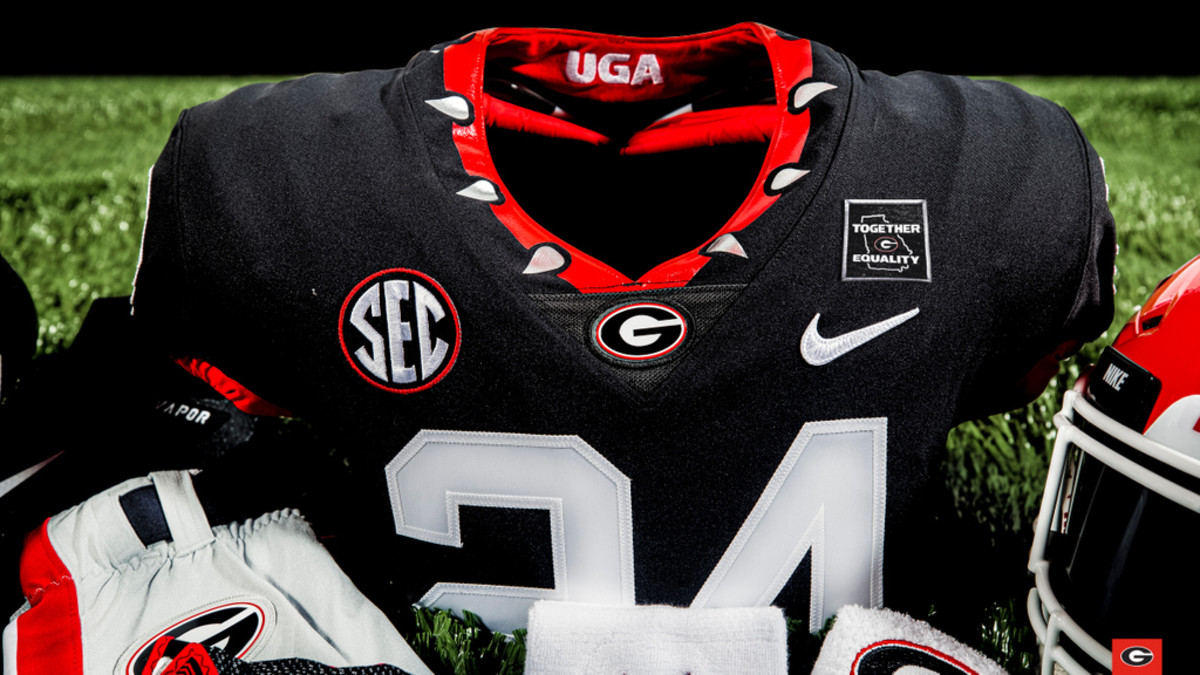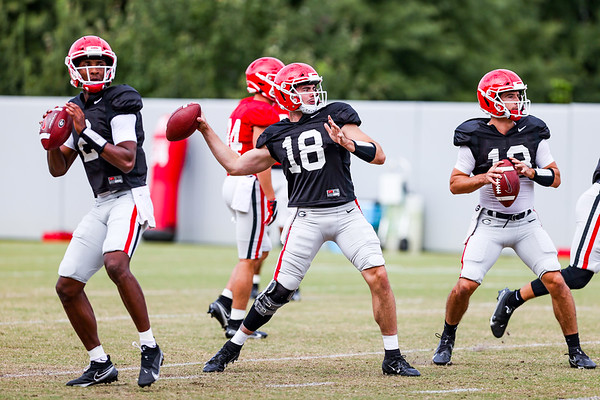Strange History, Mysterious Origins of Georgia's Black Jerseys
What is something that isn't a big part of Georgia football, but feels like Georgia football?
Black jerseys seem to fit that description. The fan-favorite alternate look has a very small footprint in the 125-plus-year history of the program. Yet, there does seem to be something traditional about them.
Maybe it's the fact that other UGA sports teams commonly wear black jerseys. Maybe it's because the team is occasionally referred to as the "red and black," which was even a short-lived nickname of the Georgia football team in the 1890s. Maybe it's because of how special that first game in black jerseys was in 2007. Or perhaps it's because seemingly every recruit that steps on campus gets a photo of themselves wearing a black jersey.
Why are Georgia fans so captivated by black jerseys, and does their history go back further than 2007? What is the history and origin of Georgia's black jerseys? Glad yuo asked.
PS, as of this morning sources indicated to Dawgs Daily on SI.com that the Black Jerseys are expected to make an appearance.
2020 refresh
In September, Georgia fans were surprised by not one but two new uniforms: the 1980 throwbacks and a new black jersey. The latter trades the thick red collar for a red, spiked dog collar and features an angular block number font and the symmetrical Bulldogs logo on the sleeves. Accompanying the jersey are the traditional red helmet and silver "britches."

Soon after introducing the new uniforms, Georgia announced that it would wear the throwbacks in the season opener at Arkansas. But no date was given for the black jerseys. A photo leaked earlier in the week showed patches being added to the black jerseys. This might be the week.
The 2016 revival that was 'supposed' to be permanent
Georgia wore black jerseys for just the fourth game ever in head coach Kirby Smart's first season. The Bulldogs defeated Louisiana-Lafayette 35-21 and the game wasn't as close as the score indicated.
Forgotten from the 2016 revival is that "blackouts" were supposed to be an annual occurrence. In August 2016, athletics director Greg McGarity said blackouts "will be one game a year. It's one of our team colors." Yet, 2017, 2018 and 2019 went by without any blackouts.
Three blackouts in nine games
For a short period across the 2007 and 2008 seasons, black jerseys were a consistent part of Georgia's uniform rotation.
The jerseys made their surprise debut in the Bulldogs' Week 11 matchup against Auburn in 2007. Thanks to popular demand, the team wore black jerseys again in the Sugar Bowl against Hawaii. Then, on the plane ride home from beating Arizona State four weeks into the 2008 season, seniors requested black jerseys for the following week's game against Alabama.
Throughout nine games, Georgia wore black jerseys three times.
The first two games were glorious. Georgia scored 28 unanswered points in the final 20 minutes to beat Auburn 45-20. The Bulldogs later broke down the Hawaii hype train with a 41-10 win in the Sugar Bowl. Then, the mystique died.
Georgia hosted Alabama five weeks into the 2008 season. Both teams were undefeated and ranked in the top 10, prompting College Gameday to visit Athens. Unfortunately, the game did not live up to expectations. Alabama led 31-0 at halftime and squashed a second-half comeback to win 41-30.
First blackout
The 2007 blackout of Auburn was a legitimate surprise. The team asked fans to wear black, sparking rumors that the team would wear black jerseys. But when black-clad fans arrived at Sanford Stadium on Saturday, they found the team warming up in red jerseys.
The team returned to the locker room, and the Redcoat Marching Band played its usual pregame medley. As the band completed its show, the kickers and team captains returned to the field, still in red jerseys. The band marched into formation, creating a path for the team to run through while the color guard lifted the banner into place.
All very typical for a Georgia game, except for one thing: the team wasn't behind the banner. As the redcoats play "Krypton," the team usually gathers around the Bulldog statue. Not this day. The team stayed out of sight until "Krypton" transitioned into "Glory, Glory to Ole' Georgia."
That was the fans' first sight of black jerseys. Georgia ran onto the field to a thunderous roar. The captains took off their red jerseys to reveal they were wearing black jerseys underneath them the whole time.
The jerseys were a big surprise for the team as well. Head coach Mark Richt had the jerseys sneaked into the locker room while the team warmed up.

Nike
Now we're getting to the birth of the modern black jerseys and the demand for Georgia to wear them. In the early 2000s, Nike started to push alternate jerseys on more teams. Not every alternate jersey was meant for the field, at least not initially.
Nike released several fan-only alternate jerseys around this time, including a black jersey matching the style of the red jerseys Georgia wore then. For the first time, fans could actually see what an actual black Georgia jersey would look like. Not only could they see it, but they could also wear it as well.
Now that fans could wear licensed, Nike-made black Georgia jerseys, they wanted the team to wear them too.
Frank Sinkwich and the mysterious black jersey shoot
Digging back far enough, there is evidence of Georgia Bulldogs black jerseys in the 1940s.
Sometime between 1940 and 1942, members of the Georgia football team wore black jerseys for a photoshoot at Sanford Stadium. Sinkwich, the Heisman Trophy winner from 1942, was one of those players and he even posed for one photo alongside head coach Wally Butts.
What was the point of this photoshoot with black jerseys? There's no photographic evidence to suggest the Bulldogs ever wore the jerseys in a game. The late Dan Magill, who knew everything there was to know about Georgia football, had no recollection of the team ever wearing black jerseys.
One possibility is that the photo shoot was nothing more than that. Butts didn't create his Georgia football style in his first season (1939). He introduced the "silver britches" in 1940 and the silver helmets in 1941. Perhaps Butts considered black jerseys and bought a small set so he could see the full uniform in person.
If so, then the black jerseys have truly come full circle. In 1940, the jerseys were used for a photoshoot featuring star players. In 2020, black jerseys are typically used for photoshoots featuring coveted high-school recruits.
